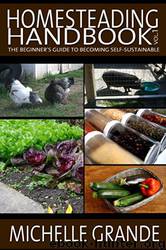Homesteading Handbook Vol. 1: The Beginner's Guide to Becoming Self-Sustainable by Michelle Grande

Author:Michelle Grande [Grande, Michelle]
Language: eng
Format: epub
Tags: Crafts; Hobbies & Home, Home Improvement & Design, How-To & Home Improvements, Sustainable Living, Reference
Amazon: B00KRTXBNW
Published: 2014-06-04T04:00:00+00:00
Here are the steps that need to be followed to water bath can produce types that are safe to can via water bath canning:
Gather the equipment and wash it in hot, soapy water. Rinse the equipment off.
Fill a pot with water and place the jars in the canner. The water should be over the top of the jars.
Bring the water to a simmer to heat up the jars. Filling cold jars with warm food can cause them to crack and this step helps prevent that from happening. Alternatively, the jars can be washed in the dishwasher right before you're ready to use them and can be filled while still hot. Take the jars out one at a time as you're ready to fill them and close the dishwasher while filling a jar.
Place new lids in a saucepan full of simmering water. The lids have to be simmered for 10 minutes in order to get the sealing compound on the bottom of each lid ready. Keep the lids in simmering water until you're ready to use them and only remove one lid at a time.
While you're waiting, prepare the food you're going to can.
Fill each of the jars with food. Use a spatula to remove any air pockets from the food. Run it around the edge of the jar.
Wipe the rim of the jar clean.
Use the lid wand to remove a lid from the saucepan and place it onto a jar. Tighten a band onto the jar finger-tight. Don't over-tighten the band. Repeat this process with each of the jars.
Fill the water bath canner with enough water to cover the jars when they're placed into it. Place the wire rack into the canner. Bring the water to a boil.
Use the jar lifter to transfer the jars into the water bath canner. The water should be an inch or two over the top of the jars. If not, add more boiling water.
Boil the jars for the recommended amount of time. Turn off the heat and let the contents of the pot cool for 10 minutes.
Use the jar lifter to remove the jars from the pot and set them upright on a towel to cool. Leave a few inches space between each of the jars. Allow them to cool for 24 hours.
Check to make sure the jars are sealed by pressing on the center of the lid. If the lid pops back up after being pressed down, a good seal wasn't created. These jars can be refrigerated and consumed in a reasonable amount of time.
The jars with a good seal can be labeled and stored at room temperature in a cool, dark location.
Download
This site does not store any files on its server. We only index and link to content provided by other sites. Please contact the content providers to delete copyright contents if any and email us, we'll remove relevant links or contents immediately.
Compact Houses by Gerald Rowan(2048)
Food Storage for Self-Sufficiency and Survival by Angela Paskett(1971)
Backyard Chickens Beyond the Basics by Pam Freeman(1885)
Lagom by Niki Brantmark(1659)
100 Skills You'll Need for the End of the World (as We Know It) by Ana Maria Spagna(1652)
The Unsettlers by Mark Sundeen(1627)
The Magickal Family by Monica Crosson(1624)
Pure Charcuterie: The Craft & Poetry of Curing Meat at Home by Meredith Leigh(1594)
Living Off the Grid by David Black(1582)
Mother Earth News Almanac by Mother Earth News(1487)
The Backyard Homestead Guide to Raising Farm Animals: Choose the Best Breeds for Small-Space Farming, Produce Your Own Grass-Fed Meat, Gather Fresh ... Rabbits, Goats, Sheep, Pigs, Cattle, & Bees by Gail Damerow(1430)
A Life Less Throwaway by Tara Button(1427)
Backyard Foraging by Ellen Zachos(1346)
The Backyard Homestead Seasonal Planner by Ann Larkin Hansen(1341)
The Sustainable Asian House by Paul McGillick(1340)
Fruit Trees, Berries & Nuts by Kim Pezza(1324)
Building Today's Green Home: Practical, Cost-Effective and Eco-Responsible Homebuilding (Popular Woodworking) by Smith Art(1248)
Life Without Plastic by Chantal Plamondon & Jay Sinha(1234)
Making Transparent Soap by Catherine Failor(1220)
